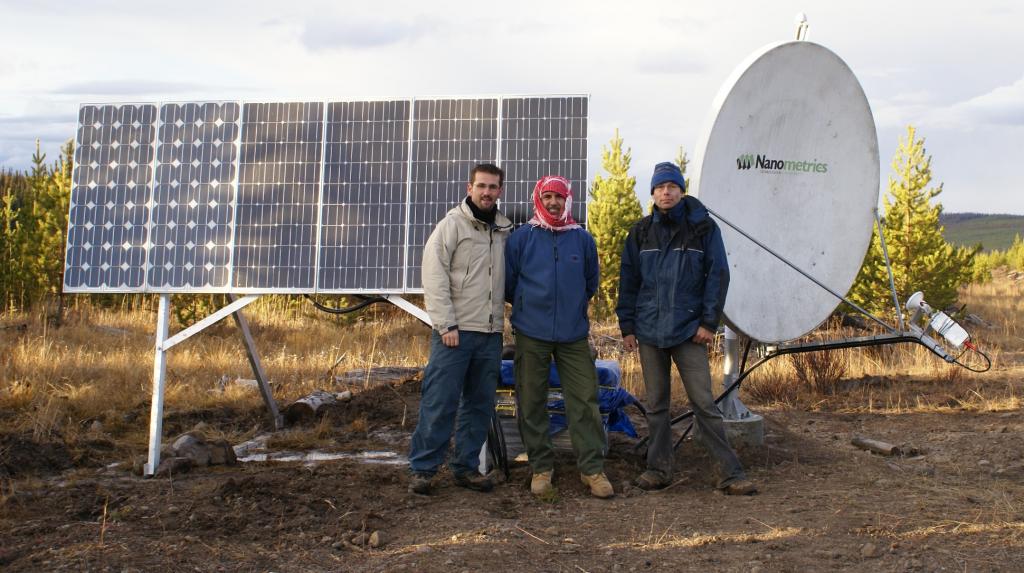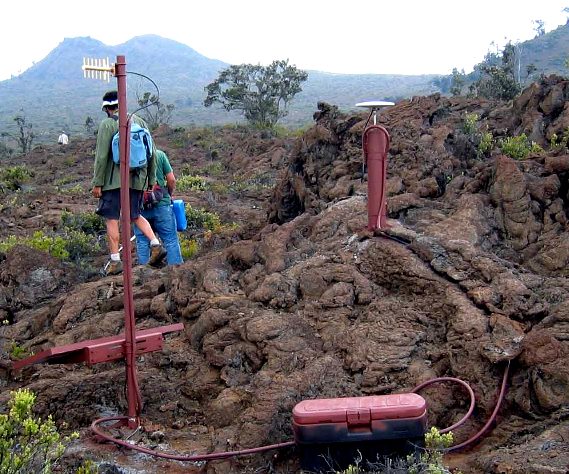38 4.5 Monitoring Volcanoes and Predicting Eruptions — Physical Geology – 2nd Edition
If there is seismic evidence that a volcano is coming to life, more seismometers should be placed in locations within a few tens of kilometres of the source of the activity (Figure 4.5.1). This will allow geologists to determine the exact location and depth of the seismic activity so that they can see where the magma is moving.

Detecting Gases
Water vapour quickly turns into clouds of liquid water droplets and is relatively easy to detect just by looking, but CO2 and SO2 are not as obvious. It’s important to be able to monitor changes in the composition of volcanic gases, and we need instruments to do that. Some can be monitored from a distance (from the ground or even from the air) using infrared devices, but to obtain more accurate data, we need to sample the air and do chemical analysis. This can be achieved with instruments placed on the ground close to the source of the gases (see Figure 4.3.12), or by collecting samples of the air and analyzing them in a lab.
Measuring Deformation
Measurement of deformation allows us to determine if a volcano is expanding or contracting. That can typically be related to the movement of magma into or out of a magma chamber near to surface and so is an indicator of the potential for an eruption. There are two main ways to measure ground deformation. One is known as a tiltmeter, which is a sensitive three-directional level that can sense small changes in the tilt of the ground at a specific location. Another is through the use of GPS (global positioning system) technology (Figure 4.5.2). Both are effective, but GPS provides more information than a tiltmeter because it can tell us how far the ground has actually moved in the east-west, north-south, and up-down directions.

By combining information from these types of sources, along with careful observations made on the ground and from the air, and a thorough knowledge of how volcanoes work, geologists can get a good idea of the potential for a volcano to erupt in the near future (months to weeks, but not days). They can then make recommendations to authorities about the need for evacuations and restricting transportation corridors. Our ability to predict volcanic eruptions has increased dramatically in recent decades because of advances in our understanding of how volcanoes behave and in monitoring technology. Providing that careful work is done, there is no longer a large risk of surprise eruptions, and providing that public warnings are issued and heeded, it is less and less likely that thousands will die from sector collapse, pyroclastic flows, ash falls, or lahars. Indirect hazards are still very real, however, and we can expect the next eruption like the one at Laki in 1783 to take an even greater toll than it did then, especially since there are now roughly eight times as many people on Earth.
You’re the chief volcanologist for the Geological Survey of Canada (GSC), based in Vancouver. At 10:30 a.m. on a Tuesday, you receive a report from a seismologist at the GSC in Sidney saying that there has been a sudden increase in the number of small earthquakes in the vicinity of Mount Garibaldi. You have two technicians available, access to some monitoring equipment, and a four-wheel-drive vehicle. At noon, you meet with your technicians and a couple of other geologists. By the end of the day, you need to have a plan to implement, starting tomorrow morning, and a statement to release to the press. What should your first day’s fieldwork include? What should you say later today in your press release?
See Appendix 3 for Exercise 4.6 Answers.
Media Attributions
- Figure 4.5.1: Photo by Cathie Hickson. All rights reserved. Used with permission.
- Figure 4.5.2: A Typical GPS Monitoring Station by USGS. Public domain.
- See: http://www.earthquakescanada.nrcan.gc.ca/stndon/CNSN-RNSC/stnbook-cahierstn/index-eng.php?tpl_sorting=map&CHIS_SZ=west ↵
<!– pb_fixme –>
<!– pb_fixme –>

